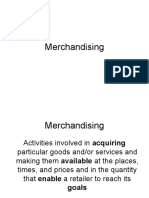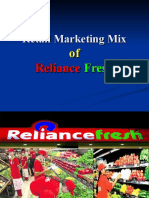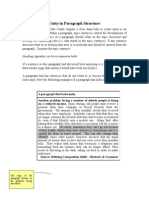Definition Retail Mix
Definition Retail Mix
Uploaded by
rohan-jain-4962Copyright:
Available Formats
Definition Retail Mix
Definition Retail Mix
Uploaded by
rohan-jain-4962Copyright
Available Formats
Share this document
Did you find this document useful?
Is this content inappropriate?
Copyright:
Available Formats
Definition Retail Mix
Definition Retail Mix
Uploaded by
rohan-jain-4962Copyright:
Available Formats
FIRST OF ALL RETAILING AN OVERVIEW BY ROHAN JAIN
The Indian retail industry is the fifth largest in the world. Comprising of organized and unorganized sectors, India retail industry is one of the fastest growing industries in India, especially over the last few years. Though initially, the retail industry in India was mostly unorganized, however with the change of tastes and preferences of the consumers, the industry is getting more popular these days and getting organized as well. With growing market demand, the industry is expected to grow at a pace of 25-30% annually. The India retail industry is expected to grow from ` 35,000 crore in 2004 -05 to ` 109,000 crore by the year 2010.
Growth of Indian Retail
According to the 8th Annual Global Retail Development Index (GRDI) of AT Kearney, India retail indus try is the most promising emerging market for investment. In 2007, the retail trade in India had a share of 8 -10% in the GDP (Gross Domestic Product) of the country. In 2009, it rose to 12%. It is also expected to reach 22% by 2010. According to a report by Northbride Capita, the India retail industry is expected to grow to US$ 700 billion by 2010. By the same time, the organized sector will be 20% of the total market share. It can be mentioned here that, the share of organized sector in 2007 was 7.5% of t he total retail market.
Major Retailers in India Pantaloon:
Pantaloon is one of the biggest retailers in India with more than 450 stores across the country. Headquartered in Mumbai, it has more than 5 million sq. ft retail space located across the country . It's growing at an enviable pace and is expected to reach 30 million sq. ft by the year 2010. In 2001, Pantaloon launched country's first hypermarket Big Bazaar. It has the following retail segments: Food & Grocery: Big Bazaar, Food Bazaar Home Solutions: Hometown, Furniture Bazaar, Collection -i Consumer Electronics: e-zone Shoes: Shoe Factory Books, Music & Gifts: Depot
Health & Beauty Care: Star, Sitara E-tailing: Futurebazaar.com Entertainment: Bowling Co.
Tata Group
Tata group is another major player in Indian retail industry with its subsidiary Trent, which operates Westside and Star India Bazaar. Established in 1998, it also acquired the largest book and music retailer in India Landmark in 2005. Trent owns over 4 lakh sq. ft retail space across the country.
RPG Group
RPG Group is one of the earlier entrants in the Indian retail market, when it came into food & grocery retailing in 1996 with its retail Foodworld stores. Later it also opened the pharmacy and beauty care outlets Health & Glow.
Reliance
Reliance is one of the biggest players in Indian retail industry. More than 300 Reliance Fresh stores and Reliance Mart are quite popular in the Indian retail market. It's expecting its sales to reach ` 90,000 crores by 2010.
AV Birla Group
AV Birla Group has a strong presence in Indian apparel retailing. The brands like Louis Phillipe, Allen Solly, Van Heusen, Peter England are quite popular. It's also investing in other segments of retail. It will invest ` 8000-9000 crores by 2010.
Retail formats in India
Hypermarts/supermarkets: large self-servicing outlets offering products from a variety of categories. 1. Mom-and-pop stores: they are family owned business catering to small sections; they are individually hand led retail outlets and have a personal touch. 2. Departmental stores: are general retail merchandisers offering quality
products and services. 3. Convenience stores: are located in residential areas with slightly higher prices goods due to the convenience offere d. 4. Shopping malls: the biggest form of retail in India, malls offers customers a mix of all types of products and services including entertainment and food under a single roof. 5. E-trailers: are retailers providing online buying and selling of products and services. 6. Discount stores: these are factory outlets that give discount on the MRP. 7. Vending: it is a relatively new entry, in the retail sector. Here beverages, snacks and other small items can be bought via vending machine. 8. Category killers: small specialty stores that offer a variety of categories. They are known as category killers as they focus on specific categories, such as electronics and sporting goods. This is also known as Multi Brand Outlets or MBO's. 9. Specialty stores: are retail chains dealing i n specific categories and provide deep assortment. Mumbai's Crossword Book Store and RPG's Music World are a couple of examples.
Challenges facing Indian retail industry
The tax structure in India favors small retail business Lack of adequate infrastructu re facilities High cost of real estate Dissimilarity in consumer groups Restrictions in Foreign Direct Investment Shortage of retail study options Shortage of trained manpower Low retail management skill
The Future
The retail industry in India is currently growing at a great pace and is expected to go up to US$ 833 billion by the year 2013. It is further expected to reach US$ 1.3 trillion by the year 2018 at a CAGR of 10%. As the country has got a high growth rates, the consumer spending has also g one up and is also expected to go up further in the future. In the last four year, the consumer spending in India climbed up to 75%. As a result, the India retail industry is expected to grow further in the future days. By the year 2013, the organized sector is also expected to grow at a CAGR of 40%.
DEFINITION RETAIL MIX. DESCRIPTION.
The Retail Marketing Mix is a marketing term that refers to the variables that a retailer can combine in alternative ways to arrive at a marketing strategy for attracting its consumers. The variables usually include factors such as: merchandise variety and assortment and services offered, pricing, advertising, promotion and layout, store design, store location, and visual merchandising. It is a specialized form of the Extended Marketing Mix for Retailers. In a typical retail business, the 7 th P (Physical Evidence) is a bit redundant, unless services are a main component of the offering (banks, online retai l, mail order).
TYPES OF RETAILERS Typically retail is a quick-paced, stimulating environment. Obviously, the retail marketing mix is dependent on the type of retailer:
Department Store : very large stores offering a large variety of categories and has broad assortment at average price. They offer considerable customer service. Discount Store : offering a wide array of products and services, but competing mainly on price. General Merchandise Store : a hybrid between a department store and discount store. Warehouse Store : offering low-cost, typically high-quantity goods piled on pallets or steel shelves. Mom-And-Pop Store: family-run, small retail outlet, owned and operated by individuals. Specialty Store : focuses on a particular category and provides high level of service. Convenience Store : found in residential areas, providing limited merchandise at above average prices with a quick checkout. Hypermarket : providing large variety and huge volumes of merchandise at low margins. Supermarket : Self-service store selling mostly food products and limited non-food items. Category Specialist : supplying very wide assortment in a single category at low prices. E-tailer: offering products through internet. The merchandise is delivered at the customer's address. Mail Order: offering products through a catalogue. The merchandise is delivered at the customer's address. Vending Machine Retail marketing is all about satisfying the customers: What matters is what the customers regard as value and most importantly what they b uy. It encompasses a wide range of activities.
ELEMENTS OF A RETAIL MARKETING MIX A good retail marketing mix must: 10. Meet the expectations of target customers 11. It's elements (see below) must be consistent with each other to create some form of synergy. 12. Be competitive to offerings from competitors . The following list of typical elements can be used to develop a strong retail marketing mix: Product (Merchandise) Product development Product management Product features and benefits Branding Packaging After-sales services Promotion Promotional mixes Advertising management Sales promotion Sales management Public relations Direct marketing Physical Evidence Shops layout, reception, checkout Shopping mall Customer-staff interaction Atmosphere Customer testimonials Cash receipt After sales service Price 13. Costs 14. Profitability 15. Value for money 16. Competitiveness 17. Incentives 18. Quality 19. Status People Staff capability Efficiency Availability Effectiveness Customer-staff interaction Internal marketing Place Target market Channel structure Channel management Retailer image Retail logistics Retail distribution Process Order processing Database management Service delivery Queuing system Standardization
You might also like
- Questionnaire On Visual MerchandisingDocument2 pagesQuestionnaire On Visual Merchandisingvsguna100% (5)
- Consumer Behaviour: External and Internal InfluencesDocument4 pagesConsumer Behaviour: External and Internal InfluencesAkshay M ChandraNo ratings yet
- Retail Structure, Types and RoleDocument24 pagesRetail Structure, Types and RoleRishab Jain 2027203No ratings yet
- Accell Group: Time To AccelerateDocument52 pagesAccell Group: Time To AccelerateAndi WangNo ratings yet
- Category Management For Mens' Casuals Apparel ForDocument22 pagesCategory Management For Mens' Casuals Apparel ForArunava Basu Ray100% (1)
- 20.integrating and Controlling The Retail StrategyDocument15 pages20.integrating and Controlling The Retail StrategySumaiyah Alifah100% (1)
- Retail MarketingDocument16 pagesRetail MarketingShweta ThakurNo ratings yet
- Essay 1 - Sustainability StarbucksDocument6 pagesEssay 1 - Sustainability Starbucksapi-312964081No ratings yet
- Business PlanDocument18 pagesBusiness PlanBruno Bernardo100% (2)
- Retail FormatsDocument16 pagesRetail FormatsswatijdhNo ratings yet
- Retail Management Introduction Unit 05Document14 pagesRetail Management Introduction Unit 05Sriram VpNo ratings yet
- MerchandisingDocument13 pagesMerchandisingrvaraprasadNo ratings yet
- Types of RetailersDocument31 pagesTypes of RetailersAadhithya ChandrasekarNo ratings yet
- RETATIL MANAGEMENT - MasterDocument38 pagesRETATIL MANAGEMENT - MasterPravish KhareNo ratings yet
- Retail Management: A Presentation byDocument37 pagesRetail Management: A Presentation bymuthepNo ratings yet
- Introduction To RetailDocument13 pagesIntroduction To Retailapi-3716588100% (2)
- Chapter 8 Atmospherics and Retail Space-Retail ManagementDocument27 pagesChapter 8 Atmospherics and Retail Space-Retail ManagementSesharaja Venugopalan100% (2)
- Project Pantaloons MarketingDocument19 pagesProject Pantaloons MarketingMunishRajputNo ratings yet
- Stores Layout and DesignDocument19 pagesStores Layout and DesignkrishnakctbaNo ratings yet
- Presentation On 4Ps of WestsideDocument30 pagesPresentation On 4Ps of WestsideRaj ParohaNo ratings yet
- Table of Contents: A. History of The Company 1 B. Retail Strategy 2Document12 pagesTable of Contents: A. History of The Company 1 B. Retail Strategy 2Aparna ShajiNo ratings yet
- SESSION 11 Allocating Retail Space To ProductsDocument27 pagesSESSION 11 Allocating Retail Space To ProductsAmisha SinghNo ratings yet
- Developing Merchandise PlansDocument24 pagesDeveloping Merchandise PlansVenera TuraevaNo ratings yet
- Retail SuccesDocument13 pagesRetail SuccesMohammad Reza BaidowiNo ratings yet
- Big Bazaar Vs Spar: Gaurav Kumar - 08PG304Document10 pagesBig Bazaar Vs Spar: Gaurav Kumar - 08PG304Gaurav KumarNo ratings yet
- Unit - II: Merchandise Management Visual MerchandiseDocument172 pagesUnit - II: Merchandise Management Visual MerchandiseRajesh Singh KumabamNo ratings yet
- Retail Question Bank AnswersDocument14 pagesRetail Question Bank AnswersJenish P. KeniaNo ratings yet
- IDM Assignment-IDocument23 pagesIDM Assignment-ISivaguru VetrivelNo ratings yet
- Introduction To Retailing by Sumit ChangesDocument118 pagesIntroduction To Retailing by Sumit Changesshaswat ghildiyalNo ratings yet
- Retail Theories and Life CycleDocument29 pagesRetail Theories and Life Cycletc23No ratings yet
- Retail FormatsDocument36 pagesRetail FormatsShaurya Thakur100% (1)
- Types of Merchandising Basic Functions of Retail MerchandisingDocument40 pagesTypes of Merchandising Basic Functions of Retail MerchandisingSWAPNIL KRISHNANo ratings yet
- Range PlanningDocument43 pagesRange PlanningGarvit GargNo ratings yet
- Lifestyle StoresDocument7 pagesLifestyle StoresSudharma VaradarajanNo ratings yet
- Retail Marketing Mix and PlanningDocument28 pagesRetail Marketing Mix and PlanningNavin Mehta100% (1)
- Unit 2 Merchandise Management: StructureDocument14 pagesUnit 2 Merchandise Management: Structureanjali_chitaliaNo ratings yet
- Systme Model Retail StoreDocument23 pagesSystme Model Retail StoreDhaval ShahNo ratings yet
- FDI in RetailDocument27 pagesFDI in RetailHimanshu GuptaNo ratings yet
- Store Visit Report at Superdry, MidvalleyDocument17 pagesStore Visit Report at Superdry, MidvalleygslSuetLinNo ratings yet
- Sales and DistributionDocument11 pagesSales and DistributionManish DhuriaNo ratings yet
- Unit IDocument64 pagesUnit IVenkat GV100% (1)
- Retail ManagementDocument192 pagesRetail ManagementadpNo ratings yet
- 7P's of Retail Marketing MixDocument25 pages7P's of Retail Marketing MixAbhishek Tudu33% (3)
- Relationship Marketing in Retailing & International RetailingDocument72 pagesRelationship Marketing in Retailing & International Retailingkiran 17mba11No ratings yet
- TcnsDocument7 pagesTcnsSWETA GOGOI-DM 21DM205No ratings yet
- Category ManagementDocument8 pagesCategory ManagementAditi JindalNo ratings yet
- Graduation Project 'Document43 pagesGraduation Project 'SushantNo ratings yet
- Multi Channel RetailingDocument19 pagesMulti Channel Retailingmanav badhwar100% (1)
- Retail Session 5,6 Retail StrategyDocument65 pagesRetail Session 5,6 Retail StrategyArun KumarNo ratings yet
- HMT Watches Revival of A Failed BrandDocument22 pagesHMT Watches Revival of A Failed BrandDarsh JainNo ratings yet
- Merchandising - Definitions, Types Principles and Functions - Retail MarketingDocument26 pagesMerchandising - Definitions, Types Principles and Functions - Retail MarketingriaNo ratings yet
- ProvogueDocument27 pagesProvogueAnurag MishraNo ratings yet
- Pantaloon Project PDFDocument56 pagesPantaloon Project PDFMonisha BhatiaNo ratings yet
- Retail Positioning: Strategy in DetailDocument8 pagesRetail Positioning: Strategy in DetailManoj Nakra100% (5)
- Amartex IV ReportDocument7 pagesAmartex IV Reportsac84hin0% (1)
- Functions of MerchandiserDocument26 pagesFunctions of MerchandiseryuktiNo ratings yet
- Retail Departmental ManagerDocument12 pagesRetail Departmental ManagerRKT SOLUTION TP Help DeskNo ratings yet
- Chapter 8 Product Services and BrandsDocument3 pagesChapter 8 Product Services and BrandsAyesha FatimaNo ratings yet
- Startegies of RetailingDocument129 pagesStartegies of RetailingDheeraja Raj100% (3)
- Value Chain Management Capability A Complete Guide - 2020 EditionFrom EverandValue Chain Management Capability A Complete Guide - 2020 EditionNo ratings yet
- Logistics And Supply Chain Management System A Complete Guide - 2020 EditionFrom EverandLogistics And Supply Chain Management System A Complete Guide - 2020 EditionNo ratings yet
- Tugas Review ArtikelDocument7 pagesTugas Review ArtikelFirdaus AnggaraNo ratings yet
- Bata India PVT Ltd.Document18 pagesBata India PVT Ltd.harsha_uNo ratings yet
- Manuscript (Final)Document16 pagesManuscript (Final)SilentPicker 03No ratings yet
- Online Shopping Project Literature ReviewDocument8 pagesOnline Shopping Project Literature Reviewafmztsqbdnusia100% (1)
- Indian Job TalksDocument14 pagesIndian Job TalksMurali PrasadNo ratings yet
- An Examination of Factors Influencing Repurchase Intention TowardDocument18 pagesAn Examination of Factors Influencing Repurchase Intention TowardKhalil BedouiNo ratings yet
- Inventory Management Technique Used in Retail IndustryDocument64 pagesInventory Management Technique Used in Retail IndustryChangoGhostery100% (1)
- Final WiproDocument32 pagesFinal Wipromegh260% (1)
- Santosh VermaDocument159 pagesSantosh VermaSantosh VermaNo ratings yet
- SPSSDocument2 pagesSPSSAdityaNo ratings yet
- Vietnam General Confederation of Labour Ton Duc Thang University Faculty of Business AdministrationDocument42 pagesVietnam General Confederation of Labour Ton Duc Thang University Faculty of Business AdministrationHồ ThưNo ratings yet
- A Project Report On: Social-Relevance To Study The Social Corporate Responsiblities Performed by The ICICI BankDocument73 pagesA Project Report On: Social-Relevance To Study The Social Corporate Responsiblities Performed by The ICICI BankjyotiNo ratings yet
- Walmart Case StudyDocument2 pagesWalmart Case StudySafijo Alphons100% (1)
- Paragraph DevelopmentDocument8 pagesParagraph DevelopmentdoggosNo ratings yet
- Consumer Satisfaction On Beauty Cream Among ISB FreshmenDocument21 pagesConsumer Satisfaction On Beauty Cream Among ISB Freshmengiang hươngNo ratings yet
- AliAhmed KamaliDocument6 pagesAliAhmed KamaliKamran RaufNo ratings yet
- Reverse Pricing Procedure PDFDocument7 pagesReverse Pricing Procedure PDFpanirbanonline3426100% (18)
- How To Solve A Case StudyDocument2 pagesHow To Solve A Case StudySaYam ReHania100% (1)
- YakultDocument17 pagesYakultErichSantosValdeviesoNo ratings yet
- Section A: Multiple Choice. INSTRUCTION: Write The Most Appropriate Response On The Line Provided To The Right of Each QuestionDocument11 pagesSection A: Multiple Choice. INSTRUCTION: Write The Most Appropriate Response On The Line Provided To The Right of Each QuestionKyrstal Chosenvessel RoseNo ratings yet
- FactSheet DecathlonDocument2 pagesFactSheet DecathlonAli RamosNo ratings yet
- Tanishq NotesDocument8 pagesTanishq NotesChandanMatoliaNo ratings yet
- Marketing For Admission Test Part1Document18 pagesMarketing For Admission Test Part1Aanchal ParkerNo ratings yet
- Malaysia: Persatuan Usahawan DinamikDocument19 pagesMalaysia: Persatuan Usahawan DinamikArgi AbiNo ratings yet
- Report MGT345Document17 pagesReport MGT345NURIN IRDINA MOHAMAD AMINNo ratings yet
- A Sample Cleaning Chemicals Manufacturing Business Plan TemplateDocument20 pagesA Sample Cleaning Chemicals Manufacturing Business Plan TemplateOladimeji Faisol AyomideNo ratings yet

























































































